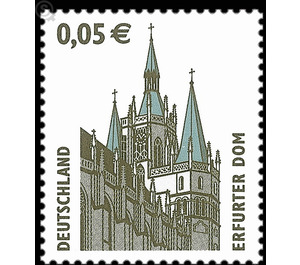Postage stamps: sights - Germany / Federal Republic of Germany 2004 - 5 Euro Cent
Theme: Architecture
| Country | Germany / Federal Republic of Germany |
| Issue Date | 2004 |
| Face Value | 5.00 |
| Perforation | K 14 |
| Printing Type | indirect 2-color letterpress |
| Stamp Type | Postage stamp |
| Item Type | Stamp |
| Chronological Issue Number | 2254 |
| Chronological Chapter | GER-BRD |
| SID | 866103 |
| In 23 Wishlists | |
The Benedictine monk and missionary Boniface, who went down in history as the holy Boniface, built around the year 728 a St. Mary's Church on the present Cathedral Hill in Erfurt. In 742 he appointed her to the episcopal church of the Diocese of Erfurt. It had to be demolished because of larger structural damage, but was rebuilt in 1154 as a Romanesque basilica with a three-nave nave, a transept and two towers on the east side. On March 25, 1349, the foundation stone was laid for an extension to the east, the High Choir. From 1455, a late-Gothic hall was built in place of the three-nave Romanesque building, which is still used today for worship. The 17-meter-high high altar of 1697, with its twelve life-size figures of saints, is a work of baroque woodcarving. The cathedral is the landmark of Erfurt, together with the neighboring parish church of St. Severi.


